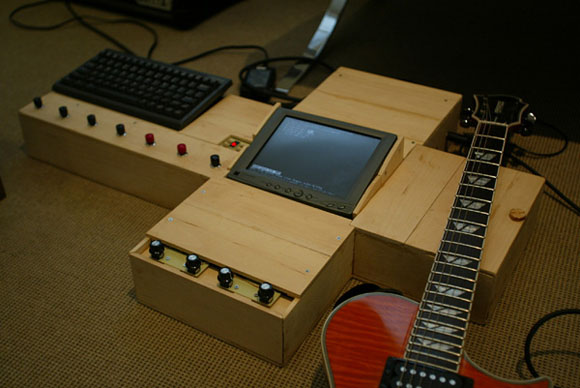 Ever wished you could open up guitar pedals and make them work the way you like? This week brought good news for you, whether your flavor is hardware or software. Prefer to wire up a simple DIY project and learn about circuitry without soldering? Or want a mad eight-core food pedal with video output and lots of jacks? Whatever your taste, Beavis and Coyote can make you happy – all without needing a gigantic crucifix form factor. (Uh … more on that in a bit. Long story.)
Ever wished you could open up guitar pedals and make them work the way you like? This week brought good news for you, whether your flavor is hardware or software. Prefer to wire up a simple DIY project and learn about circuitry without soldering? Or want a mad eight-core food pedal with video output and lots of jacks? Whatever your taste, Beavis and Coyote can make you happy – all without needing a gigantic crucifix form factor. (Uh … more on that in a bit. Long story.)
The Beavis, shipping now, offers everything you need to wire up 25 sound-shaping circuits, from parts to multi-meter to integrated breadboard. The OpenStomp Coyote takes a different approach, with a programmable processor and Windows visual patching software. Update: We should add in one commercial project to the mix, Line 6’s ToneCore DSP Developer Kit.
My First Guitar Pedal Electronics Kit

Via Music Thing, the Beavis Board is a beginning electronics DIYer’s dream. US$249 buys you a full kit of everything you need to wire up your own guitar pedals, newbie-friendly – no soldering, no parts hunting, no … actual thinking required. Of course, what’s likewise wonderful about that is you can tool around with all different combinations. The crawl of possible circuit layouts reads like one of those infomercials. (Just look at everything you get! Best hits of the 80s! Air conditioner repair!)
MXR Distortion + â— LPB-1 â— Brian May Treble Booster â— Gretsch Controfuzz
SHOw Booster â— Orange Squeezer Compressor â— Muff Fuzz
DOD Overdrive 250 â— Fuzz Face â— Muff Fuzz â— EA Tremolo
Cigarette Amp â— Ruby Amp â— Noisy Cricket Amp â— Trotsky Overdrive
Atari Punk Console â— Dual Oscillator Tone Generator
Boutique Tube Screamer â— PWM â— Red LLama
567 Modulator â— Bazz Fuss
Mockman â— IC Buffer â— JFET Bufferand more are being added to the list!
Brilliant stuff. It even comes with parts, a guide, and a multimeter included. I don’t think I’m allowed to add any more projects here, but if you get one, let us know how it goes.
Of course, this is all electronics and wires and stuff. We like software somewhere in the equation.
Open Source Pedal
If you were thinking in the previous description “yes, but imagine the flexibility if this were all programmable digital stuff instead of wires,” we’ve got the pedal for you. The OpenStomp Coyote-1 is an eight-core computer (or eight-“cog”, if you like), made of independent, 80MHz cores on the Propeller processor. That means it does all sorts of fabulous digital stuff:
- 44kHz, 24-bit sampling (2-in, 2-out)
- 1MB RAM sample memory
- USB jack
- RJ-45 expansion
- NTSC video out
— wait a second, back up here. It does video. You heard that right.
If this all conjures up images of stepping on a computer, worry not: the finished design will have some features borrowed from, you know, guitar pedals:
- Audio input and output jacks
- Stomp switches, control knobs
- Headphone jack
- Steel chassis
Someday, it will look like this:

But for now, it looks more like this:

More photos and discussion on the Parallax forum
But it should be worth the wait. You’ll be able to create custom patches graphically using a Windows app and exchange custom effects and patches with a community of users. We’ll be watching this to see how it develops.
Howler Audio Coyote-1, as seen on Livepa and via John Biggs on CrunchGear
Update: Lastly, I neglected to add the commercial alternative, the ToneCore DSP Developer Kit from Line6. It isn’t open-source like this project, but Line6 is certainly respected in their ability to do these things. The idea is basically the same: program the onboard DSP and roll your own pedal. (I don’t know that it’ll be as easy as OpenStomp; I guess we’ll see.) Here’s a video from the German Messe tech show in March, from our friends over at SonicState.com:
Why, we haven’t seen anything like this since the insane Jesusonic, which was rather inconveniently built into a giant crucifix before it made a comeback in software form in the beloved, absurdly affordable Reaper.

I’m guessing the foot pedal will be a slightly easier burden to bear.